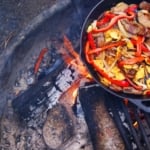5 Easy Casserole Recipes You’ll Love!
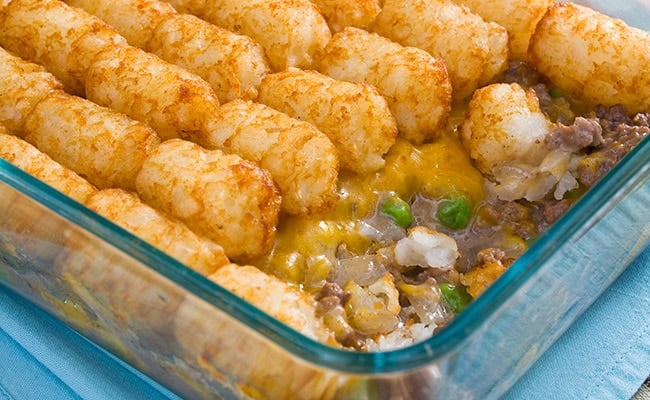
Looking for easy casserole recipes? Here are five delicious recipes that will melt in your mouth and cut your meal prep time in half!
Tater Tot Casserole Recipe
A popular casserole among kids of all ages, this tater tot casserole works well for brunches, sleepovers, or everyday events. (Pictured above.) Serves 8-10.
INGREDIENTS
- 1 small onion, chopped
- 2 lbs. ground beef
- 10.5 oz. can cream of chicken (or cream of mushroom) condensed soup
- 2/3 cup milk
- 2 cups of fresh or frozen chopped vegetables such as carrots, peas, corn, or green beans
- 2 cups cheddar cheese, grated
- 28 oz. bag of tater tots
- Salt and pepper to taste
DIRECTIONS
- Sauté the onion and ground beef together until the meat is cooked throughout.
- Add vegetables and cook another 10 minutes.
- Add the soup and milk. Stir thoroughly.
- Pour the mix into a 9×13” baking dish.
- Evenly sprinkle the shredded cheese over the meat and vegetables.
- Top with a layer of tater tots carefully placed in rows.
- Bake at 375 degrees F for 40-50 minutes, until the tater tot casserole is golden brown.
Breakfast Casserole Recipe
Instead of using bread, this recipe opts for shredded potatoes as a hearty and filling starch to fuel the day. You can also sneak in zucchini to add more vegetables to the dish. Serves 8-12.
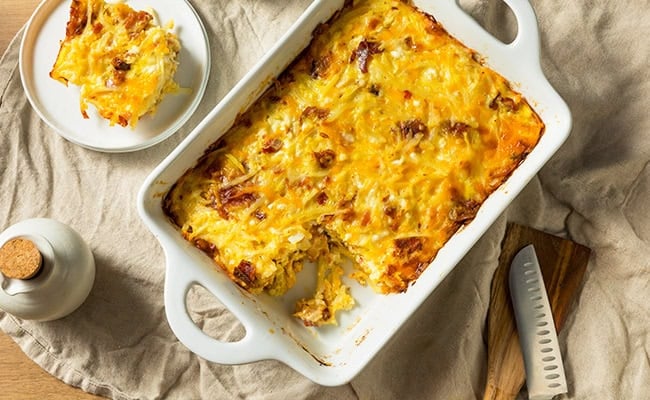
INGREDIENTS
- 1 lb. package of bulk breakfast sausage
- 1 large onion, chopped in small pieces
- 1/4 cup butter
- 2 large potatoes, peeled and grated
- 2-3 cups zucchini, fresh or frozen (optional)
- 12 eggs
- 2 cups milk
- 2 cups cheddar cheese, grated
- Salt and pepper to taste
DIRECTIONS
- Melt the butter in a large saucepan and add the chopped onions. Cook for 2 minutes, then add sausage. Break it up into small pieces.
- If using zucchini, place in a colander to drain excess water.
- Once the sausage is broken up, add grated potatoes and zucchini. Cook for 8-10 minutes.
- Whisk together eggs and milk. Add the cheese, salt, and pepper.
- Transfer the sausage and potato/zucchini mix into a buttered 9”x13” pan. Pour the egg mixture over the top and mix everything together.
- Bake at 350 degrees F for 50-60 minutes, or until the eggs are set and the casserole is browned on top.
Chicken & Biscuit Casserole Recipe
This is a favorite for a weekday dinner or to take to a friend who could use a warm and hearty meal. It’s also excellent way to use leftover chicken or turkey for a post-Thanksgiving dish. The crispy biscuits filled with cheese baked on the top make it extra special. Serves 8-10.
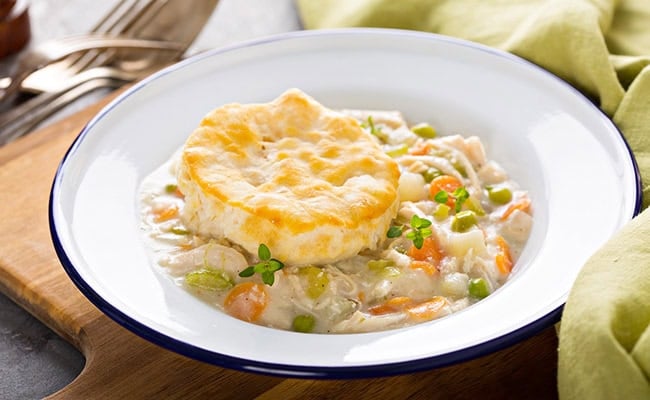
INGREDIENTS
- 4 tbsp. butter
- 1 large onion
- 4-5 sticks of celery, chopped
- 4-5 carrots, chopped
- 1 cup frozen peas
- 6 cups of chicken (or turkey), cooked and cubed
- 3 tbsp. flour
- 2-3 cups chicken broth
- For the biscuits:
- 3 cups flour
- 1/2 tsp. baking powder
- 1/2 cup cold butter
- Pinch of salt
- 1 cup milk
- 2 cups shredded cheddar cheese
DIRECTIONS
- Melt the butter in a large saucepan and add onions, celery, and carrots. Cook for 5 minutes and add the frozen peas and cooked chicken.
- Add a couple of cups of chicken broth and cook for another8-10 minutes. Take an additional 1/2 cup of broth and whisk in the flour until smooth. Add to the chicken and vegetables and mix thoroughly.
- Continue to cook to thicken. Add additional broth if it is too thick. Simmer while making the biscuits.
- To make the biscuits: Put the flour, baking powder, and salt in a bowl. Slice the cold butter into the mix and use a fork or pastry blender to cut the butter into the flour until it is in pea-sized pieces. Add the cup of milk and mix, but not too much. You don’t want to break up the pieces of butter that create the flaky biscuits. On a floured surface, roll out the biscuit dough until it’s approximately 14″ long and 9″ wide. Sprinkle the grated cheese over the rolled-out dough and roll up. Cut into 12 even pieces.
- Place the chicken and vegetable mix into a buttered 9×13” pan. Add the biscuit pieces on top.
- Bake at 425 degrees F for approximately 30 minutes or until the biscuits are golden brown.
Hamburger Casserole Recipes
Hamburger casseroles are steeped in cultural history throughout the world. Lasagna, for example, technically qualifies as a casserole. Here are regional hamburger casseroles from the United States, including recipes for Johnny Marzetti and a tourtiére:
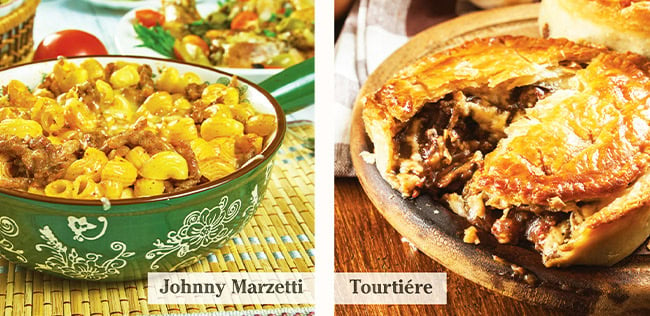
Minnesota: Back in the 1930s in the upper Midwest, the Grace Lutheran Ladies Aid published a recipe for the quintessential hamburger casserole in a Minnesotan cookbook, making a meal out of hamburger, onions, celery, canned peas, canned tomatoes, soup, and macaroni.
Southwest: Cowboy Casserole is made with ground beef, sausage, beans, tomatoes, sweet peppers, and roasted chili peppers. Add ground cumin and chili powder for a pop of flavor, and top with shredded cheese.
Northeast (and Canada): Tourtières, a French-Canadian meat pie uses lard for a beautiful flaky crust. (Try this Pork Pie Tourtiére Recipe.)
Ohio: Originating in Columbus, Ohio, a baked combination of ground beef, tomato sauce, cheese and pasta was made popular by Teresa Marzetti, who named it after her brother-in-law and served it at her family restaurant. (See recipe below.)
Johnny Marzetti Casserole Recipe
This recipe for Johnny Marzetti Casserole is a Farmers’ Almanac favorite. Serves 6-8.
INGREDIENTS
- 8 ounces elbow noodles
- 1 pound ground beef
- 1/2 pound mild Italian sausage
- 1 onion (chopped)
- 1/4 cup celery (chopped)
- 2 mushrooms (diced)
- 2 cloves garlic (minced)
- 1 tablespoon red pepper (minced)
- 1 (15 ounce) can tomato sauce
- 1 (14.4 ounce) can diced tomatoes
- 2 cups Italian cheese blend (shredded)
- 1 1/2 cups cheddar cheese (shredded)
- 1 tsp sugar (optional)
- 1 tsp thyme (dried or fresh)
- 1/4 cup fresh parsley (optional)
- Cooking spray or butter
- Salt and pepper to taste
DIRECTIONS
- Preheat the oven to 350 degrees F (175 degrees C). Grease a 7×11” or 9×9” casserole dish with cooking spray or butter.
- Boil water in a large pot. Add elbow noodles and cook until tender yet firm, about 7 minutes. Drain and run cold water over pasta. Drain again.
- While the pasta is cooking, cook beef and sausage in a large skillet over medium-high heat until completely browned, approximately 10 minutes. Add onion, celery, garlic, pepper, mushrooms, and thyme. Cook, stirring, until tender, about 4-5 minutes. Add salt and pepper to taste. Remove from the heat. Add tomato sauce and diced tomatoes. Let cool for 3-4 minutes.
- Add pasta to the casserole dish. Then put a layer of Italian cheese on top. Next, pour a layer of veggies and meat sauce. Cover the dish with aluminum foil. (Heavy duty aluminum foil works well.)
- Bake for 40-45 minutes. Remove the foil and add a layer of cheddar cheese over the casserole. Continue to bake until the cheese has melted, about 4-5 minutes. Garnish with chopped parsley. Rest for 10 minutes before serving.
Any questions? Contact [email protected]
Casserole FAQ
What are casseroles?
A casserole is a one dish meal (or side dish) that is baked in an oven. Portable and easily reheated, casseroles are an affordable option for feeding a crowd—perfect for any potluck or party.
Casserole recipes often include protein, vegetables, and a starch that is brought together with a cream sauce or cheesy goodness.
Why should you make a casserole?
The popularity of casseroles in their many forms ebbs and flows, depending on the economy and changes in society. Baking a casserole is an excellent way to use up ingredients in the refrigerator or make the most of less-expensive ingredients. For many people, bringing a casserole to a gathering is a symbol of community.
Whether your family is welcoming a new baby or dealing with an illness, casseroles offer an instant and complete hot meal that often tastes even better the next day. Made from scratch, this filling, easy comfort food is a way people share important moments the most delicious way possible.
When were casserole recipes invented?
While many may think of the classic casserole as being an invention of the post-war years, this tasty comfort food dates back more than 700 years. The French enjoyed communal-style meals made in one pot, and referred to them as casseroles, meaning “saucepans.”
Casserole recipes surged in popularity during the depressions of the 1890s and the 1930s, as well as both World Wars, because they excellent ways to combine inexpensive or leftover ingredients for a filling meal.
By the time the 1950s rolled around, there was a radical change in ingredients available to the post-war housewife, including canned soups that became the lifeblood of any proper casserole recipe.
In addition, oven-proof cookware, such as Pyrex and CorningWare, allowed the dish to go from the oven to the table, making these meals fast and convenient.

Amy Grisak
Amy Grisak is a freelance writer, blogger, and photographer specializing in gardening, local food, and stories about her home state of Montana. She enjoys sharing her experiences with self-reliant living and outdoor recreation. Her article on the "hugelkultur" gardening technique appears in the 2021 Farmers' Almanac. You can follow her topics on her site, AmyGrisak.com.



